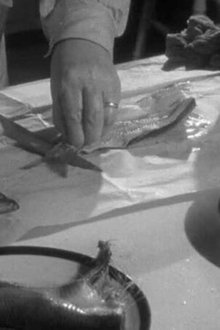Explains the first aid treatment for burns and scalds to relieve pain, to prevent or treat shock, and to prevent infection. Discusses the different types of burns and demonstrates the proper treatment for each. Shows applications of appropriate bandages and cover dressings, and emphasizes the correct and prompt treatment for physical shock.
Related Movies

Herrings (1940)
This informative herring aid from WWII makes no bones about the need to make the most of every fish.

National Milk Cocoa (1944)
Drinking chocolate flashes before your eyes and makes an offer you can't refuse.

Dr. Wise on Influenza (1919)
A hard-hitting public information film made at the height of the Great Influenza 1918-18.

It Might Be You (1946)
A doctor talks about the number of injuries and deaths resulting from automobile accidents.

Sheep Dog (1939)
Tom Jones, a shepherd who lived in one of the Ystradfechan Cottages at Old Farm, Treorchy, was employed by the Ocean Coal Company who owned the land above ground and coal (the Park and the Dare Collieries) beneath. A farrier who lived in the adjoining cottage tended to all the Park and Dare pit ponies. Tom Jones was known world-wide as the “Wonder Shepherd” for his remarkable skills as an animal trainer which, together with his concern for his flock, are recorded here.

Mrs. T. and Her Cabbage Patch (1941)
Poetic tribute to Mrs Turner's vegetable growing prowess, plus the delights of "wartime steaks".

Simply Metric (1973)
A guide to going metric from the Central Office of Information on behalf of the Metrication Board.

Searching (1974)
A haunting fire prevention film about keeping matches out of the hands of children.

Mong Kok First Aid (2020)
Mong Kok First Aid investigates the experiences and unheard stories of a group of young volunteers who provided First Aid services to wounded participants during Hong Kong’s landmark Umbrella Movement of 2014. Just half a decade later, their first-person narratives reveal an intense feeling of time passing and memories fading, as this documentary seeks to challenge history by intervening to supplement the record. After all, who decides whose story can be a part of history?

Your Chance to Live: Heat Wave (1973)
The film highlights the dangers of extreme heat and the importance of staying hydrated and cool. It portrays a conversation between two friends, one of whom insists on playing basketball despite the oppressive heat. The narrative emphasizes that heat-related illnesses can be avoided by recognizing the body's signals and taking necessary precautions, such as drinking water and staying indoors. The film concludes with a report of record-breaking temperatures, underscoring the seriousness of heat exposure.

Your Chance to Live: Pollution (1973)
A surrealistic look at the future if man does not learn to control pollution.

Public Shelter Organization and Staff (1963)
Created in 1963 at the height of the Cold War, this Civil Defense training film uses a dramatic premise to show how emergency staff should manage and organize a large public fallout shelter during a crisis. A Shelter Manager is shown immediately taking control of the situation in the shelter, speaking calmly to those who have made it into the facility, closing the door promptly once the shelter is full, and sticking to the "shelter plan" as the situation unfolds. Some of the areas discussed in this nuclear war drama are the safety plan, regular inspections, supervised public entry into shelters, ventilation, first aid, sanitation, fire prevention, decontamination of personnel, and more. "Shelter living is different," the Manager states, "But we have a trained staff that will make your stay in this shelter livable for us all."

Your Chance to Live: Winter Storm (1972)
Intercuts scenes from Jack London's To build a fire with modern urban and rural winter scenes to point out the dangers of winter storms and low temperatures. Designed to stimulate discussion on civil preparedness for winter storms.

Chlorine and the Firefighter (1974)
This 1974 film is dedicated by the Chlorine Institute to the public interest. It is specifically intended to assist firefighters and other emergency services. The techniques demonstrated are appropriate for emergency use; different circumstances might require modified or additional procedure. The information is drawn from sources believed to be reliable. The Institute, its members any organizations cooperating in the development of this film, jointly or severally, cannot be responsible for how the information is used and must make this legal disclaimer. This is a 1960s era, color movie about Chlorine and emergency workers… specifically, firefighters. The film is intended to show firefighters what chlorine is, what a chlorine emergency might involve, how a company can plan ahead and how an emergency can be handled safely.

Lifesaving and Water Safety: Snorkeling Skills and Rescue Techniques (1972)
The film provides a comprehensive guide on snorkeling skills and rescue techniques, emphasizing the importance of proper equipment such as masks, snorkels, and fins. It discusses how to choose the right mask for comfort and fit, the proper use of snorkels, and techniques for clearing water from both masks and snorkels. The film also covers essential skills for entering the water safely, practicing buddy systems during snorkeling, and techniques for locating and rescuing submerged victims. It highlights the need for training and emphasizes that while these skills are crucial for rescue, they do not replace the need for a full certified course in skin diving.

Emergency First Aid Series: Burns (1980)
Discusses the seriousness of burns, categorizing them into three degrees based on depth and severity. First-degree burns affect only the surface layer of skin, while second-degree burns penetrate deeper and are more painful. Third-degree burns are the most severe, damaging skin, muscles, and nerves. First aid varies by burn severity, emphasizing the importance of cooling the burn, avoiding ointments, and seeking medical help for serious cases. Chemical burns require immediate washing with water, and specific procedures for eye exposure are outlined. Quick medical attention is crucial to prevent complications such as infection and shock.


